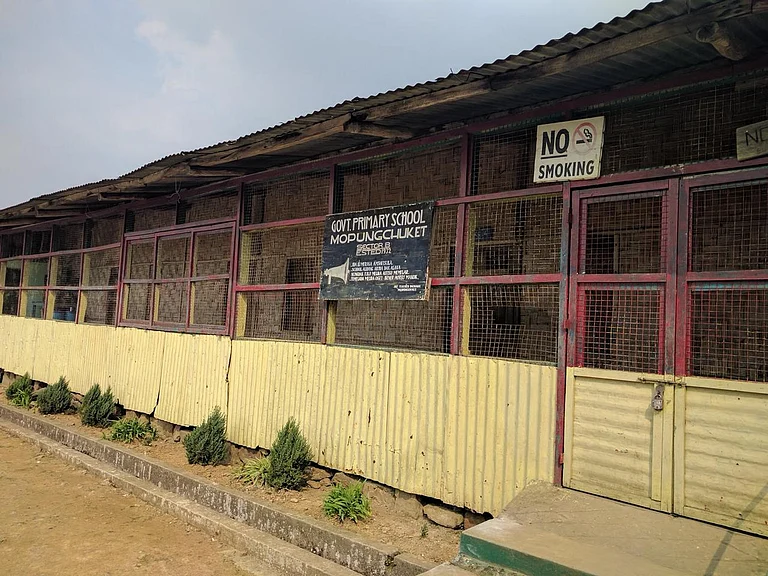Is it the absence of words? The disappearance of voice? Blocking the passage of thoughts? Meditation? The last stage of Nirvana? Locking down the organ factory ─ the pulsating heart, the beat in the veins, the movement of the bloodstream, and breathing? Death, and by extension a graveyard, ashes? A photograph of a stone-faced child or Stonehenge? A rock or swelling smoke from a cigarette? An embryo inside a permafrost? Windless grasslands? The way time unfurls for a stop-motion figurine? Switching off all electronic appliances? Negation of Time itself? Silence that is isolation and terrifying between two lovers?
The history of deep sound is older than atoms and stars.
I have often believed that the existence of space is the reason for all sounds everywhere. Not sound as sound waves that cut through the blazing plasma of protons and electrons and birthed stars and the livable universe. Nor sound as surrounding radiation, but sound as craft, endurance, and inseparable from existence. Time traveling through space discharges auditory particles. Friction of two colossal forces and sound is the collateral damage. From time 0 to time 1, from hunger to emaciation, from inertia to the need for hunting, from one location to motion across space, from muteness to the invention of sound. Warning! Mating! Whittled on the temporal lobe, I have all the memories of my first primordial parents looking up at the skies, one hand on the mouth, another outstretched upwards, praying for silence. Perhaps, after long, long days and nights of scavenging and gathering, smelling their jungle, trailing the animals, disguising, imitating, calling in/calling out, flailing the meat, failing at the bone, masticating, and then ruminating, they realized that accidental thing ─ sound emasculates. That some disastrous curse had fallen upon them. That, from this day onwards, life would be a stain upon silence. Out, out of the caves, douse the fire burning, back to eyes on the skies, that insistent hand, and those stuttering groans of beings trembling in the cold! These early things of the deeper time knew that cosmic time and astronomical spaces were anomalies. Up there, there is neither space nor the gravity of time. Say, a hypothesis: a dead astronaut drifting through emptiness is swallowed by a black hole and eventually reaches the point of singularity. Zero volume, infinite density! That is precisely where all sounds end ─ at the catastrophic center of spacetimelessness. And, like my ancient foremothers, I refuse instruments that register interplanetary infrared rays, gamma rays, microwaves, radio waves, and transmute them into sounds via sonification; I abandon the Plasma Wave Subsystem of Voyager 1 and its recorded plasma vibrations and ionized gases; I shut my ears to the noise of Jupiter’s magnetosphere and the way Saturn talks to its moons; take your space junk away from me and your knowledge that black holes sing in B-flat.
Beyond a point, I do not condemn single-celled organisms or uncontrollable evolution. Paleontologists presume that for the first few billion years the Earth was entirely silent, save the sounds of oceans and rains, winds and stones, and the undetectable susurrations of bacteria and other microorganisms. From the microbes and jellies 4 billion years ago to the first explosions of life 500 million years back, the planet was unfamiliar with the clamor of desire. Only vibrations and tremors in liquid, no communicative trilling or songs on land! Imagine the scurrying of arthropods or cephalopods over sands and shells. After the passing of almost 200 million years, the earliest insects molded the acoustic setup of the old habitation. The bush crickets or the extinct Permostridulus bucked their tymbals to register their presence ─ the first such example of bleating exoskeletons. Sounds from the cicada were the only breathing addition to the orchestra of water and plant music. Two distinct events contributed to the diversification of sonic pluralities on land and in waters ─ the disintegration of the supercontinent Pangaea and the blooming of varieties of flowering plants. Though there is startling evidence of the larynx in the advancing vertebrates, there is still uncertainty about the performative function of the cartilage. Around the Mesozoic period, we listen to the wholly developed vocal machinery producing growls and trills and witness the growth of the mammalian ear. And around 70 million years old is the first songbird, Vegavis, with its syrinx and frequency-modifying avian trachea. The Earth resonated with abstract articulations of sex, danger, and death. Simultaneously, bats advanced with their ultrasonic echolocation devices and whales expanded their sonic range with their giant larynxes. Stridulating of corrugated ridges, purring and squeaking of high-speed muscles, pulsating of ribs, clicking of neck bones, strumming of fins, slamming of claws, populated the depths of oceanic-sonic life. As an afterthought to sounds that traveled a few hundred feet to thousands of miles, we learn about the inception of broken sounds in the forms of language and symbolic thought emanating from Homo erectus some 3 million years in the past. However, before human speech, we come across human breaths flowing into hollow animal bones and the arrival of music. Genetics, memory, hearing, and cultural changes assisted in the metamorphosis of our vocal culture and linguistic intelligences. Still, grammatical and syntactical humans are not older than a few thousand years. It was only with the coming of humans that this enormous buffet of land percussions and terrestrial thumps transformed into sounds interpretable and differential. There was now a recorded polarity and variance between arboreal murmurs and vocal impressions from predators. Nature’s unified footprint was inundated by the ambivalences in language.
Sounds of everything natural are overwhelmed and overwritten by urban noises from modern machines and warring nations. These are the soundscapes of erasure: the fulmination of bombs, forest grounded by bulldozers, the clatter of heels, the commotion of vehicles, incessant construction of massive structures, overfished seas, seismic gunfire of drilling rigs in the oceans, the barrage of military ships, the quiet tumults of Curiosity Rover, the smashing of the hadron collider, the wheel and the engine, the crane and the turbine, the elevator and the drone, the motherboard and the mechanoid. Every invention has added to our inattention, our dissonance, our disconnection with the biodiversity of sounds, and our sensual embodiments. The original sin was not listening to non-human others. The crimes continue still in our forgetting of the extinct subtropical Kauaʻi ʻōʻō bird’s nocturnal pealing, the solitary stillness of the last northern white rhinoceros, the golden toad, the pinta tortoise, the Cuban macaw, and whales and seabirds that choke on ingested plastic debris.
To listen is to be open to endless possibilities and stories of deep time.
The mutation of silence was a tragic misstep in planetary progression. As survival-obsessed temporal beings, we are stuck between two infinities ─ time before us and time after us. We are self-propelled sacrificial casualties. And everything that we are/were/become will be relics in stone. Today’s waste, tomorrow’s artifact! Once again, interspecies decayed deposits will turn into sediment; all excesses and sovereignties into anaerobic chemical residue; our devices and frescoes into sludge and silt.
Imagine, one last time, an outsider on this planet, an alien archivist with a magnifier and transcribing apparatus from one of the multiverses. The outsider tracks down the antecedents, observes the Earth as readable matter, and traces the dark ages of a parasitic genus that collapsed due to infighting and colonial possessions, due to imaginary wars over myths and pigmentations. For days, the outsider will hang on to our fractal and vertiginous geostories. A sequential chronicle of anthropocentric events will burst out of the cracks on the rocky jaws of fossils. Fossils will remember and narrate the anecdotes of genocide and irreversible climate catastrophes, of fossil fuels and factories, of livestock and carbon dioxide. Human history and its brief duration scanned with the aid of bacterial metabolism and unconsecrated transubstantiation! It is the inevitable destiny of all sounds of human survival to end up as silent inscriptions on the Earth’s sheets and layers. The plot begins now, by imagining humans as bones subsumed by inhuman forces, humans as fossils to come.
A return to silence will only be possible with the extinction of the human species. However, it is not another kind of replacement, repetition, or recurrence of the entire drama of civilization. The dream is that of an accelerated vanishing of the Anthropos (perhaps a virus that only affects the human anatomy?) and all its related sounds. A world of disanthropy between preanthropy and postanthropy. It will be a restoration of Gaian sounds at the expense of human silencing. The Earth will take time to recover and return to timelessness. It will renovate and recondition the wounds from this geological epoch, perhaps even overhaul the entire ecosystem. Strange beasts will emerge out of human-historical dregs. They will be silent in the beginning; there will be silence from the old animals out of compassion for the ones extinct. And one sudden day, from the irreverent ribs of a dying bird, a symphony will erupt. And like some chimerical climax of a folklore, to every animal its own voice! There will be silence one more time. Not silence that is an antipode to sound. It will be silence that is insistent, silence that exists despite and in defiance of sound.
(The Author is an Assistant Professor at SRM University-AP























